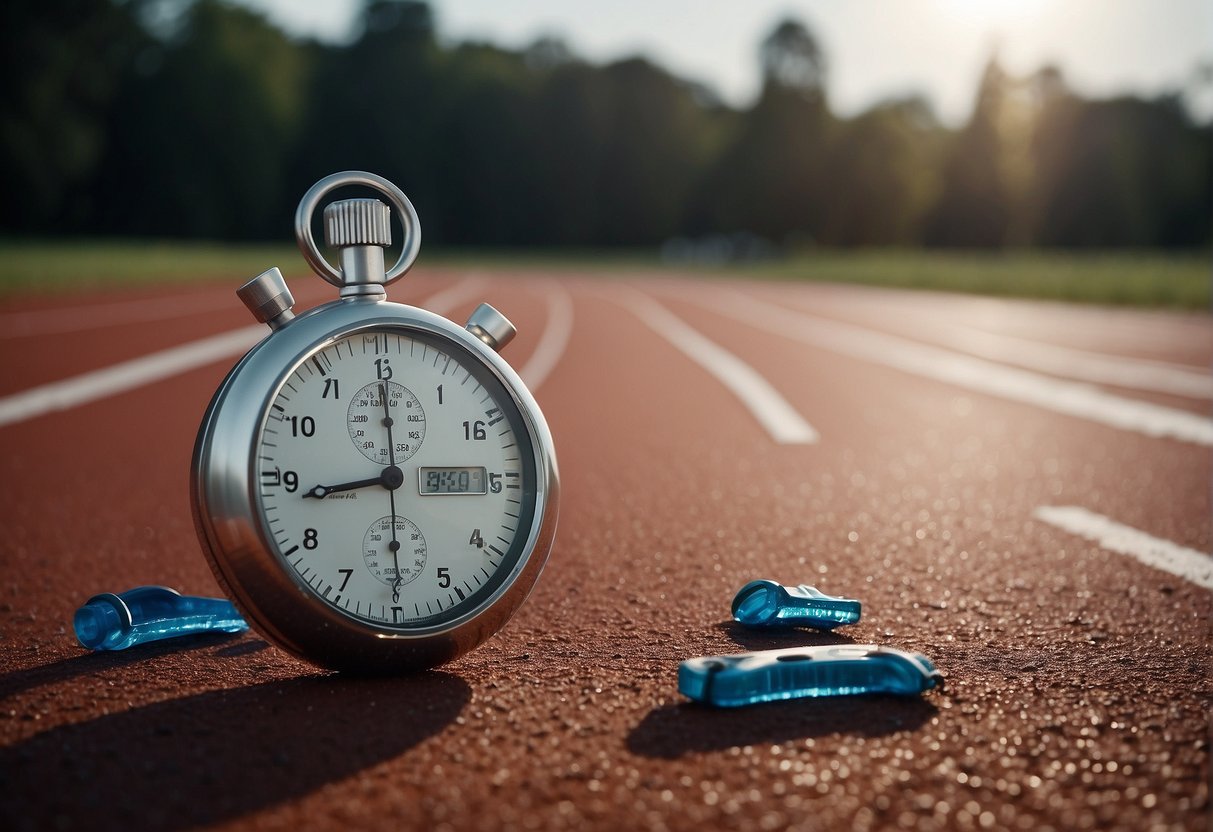Understanding your 5k running pace is fundamental to preparing for a race or building your running routine. It is the average time it takes to run one kilometer or one mile during a 5k run, which equates to 3.1 miles. You can set realistic training goals, optimize your running form, and develop effective race day strategies by pinpointing your pace. Whether you are a beginner aiming to finish your first run or an advanced runner looking to break personal records, knowing and managing your pace can significantly enhance your performance.

Improving your 5k running pace requires consistent training, intelligent tactics, and listening to your body. Training for your 5k pace means working on both speed and endurance. This can involve interval training to boost speed, long-distance runs to build endurance, and regular pace runs to understand how it feels to maintain a specific speed. On race day, it’s essential to start at a pace that feels sustainable and then, if possible, gradually increase your speed. Keep in mind the importance of proper running technique and form, which can help prevent injuries and improve efficiency, making your runs more effective.
Key Takeaways
- Understanding your 5k running pace is essential for setting training and race objectives.
- Regular training and adopting proper running techniques are key to pace improvement.
- Strategic planning for race day can influence your overall performance and race outcome.
Quick Navigation
Understanding 5K Running Pace
Engaging in a 5K run requires knowledge of pacing to achieve your best performance. Accurately tracking average pace and time, using helpful tools like pace calculators, and considering factors like age and gender are crucial for setting realistic goals and improving running capabilities.

Average Running Pace
Your average running pace is the time it takes to run a kilometer or a mile, and it is a crucial indicator of your fitness and running efficiency. For a 5K race, the average running pace for a new runner might be over 10 minutes per mile, while more experienced runners may average closer to 7 minutes per mile. Understanding and tracking your own pace helps set achievable goals and measure progress.
Pace Chart and Calculators
Pace charts serve as a guide to help protect your finish time based on a particular pace and can also suggest pacing strategies for your race. A pace calculator is invaluable in your race preparation, as it considers your recent workout or race times to predict your 5K finishing time and pace. Conveniently, these tools often provide pacing times split into age groups and genders, giving you a more personalized and accurate pace target.
Influence of Age and Gender on Pace
Your age and gender significantly influence your 5K running pace. As you age, your pace tends to slow down due to changes in muscle mass and cardiovascular health. However, excellent training and conditioning can help mitigate these effects. Generally, males might have a slightly faster pace on average than females in the same age group, but this varies widely between individuals. Setting pace goals tailored to your demographics is essential, considering these influences to maintain a competitive edge.
Setting Realistic 5k Running Pace Goals

When aiming for a 5K run, setting a realistic pace that aligns with your current fitness level and helps you achieve a personal best is crucial. Here’s how to pinpoint your goal time and assess your fitness to establish an attainable goal pace.
Establishing a Goal Time
To determine your goal finish time, consider previous race times and how much time you have to train. You might try running a mile at your maximum effort and adding 35-40 seconds per mile to estimate your 5K race pace for a more quantifiable approach. This provides a baseline for what you can achieve; from there, you can set a specific and attainable goal time.
Assessing Current Fitness Level
Your current fitness level is the cornerstone of setting a realistic goal. Conducting an honest evaluation that includes recent run times, weekly mileage, and the intensity of workouts is essential. This assessment helps tailor your goal pace to align with your abilities, reducing the risk of injury and burnout by establishing an attainable goal. Specific goals that match your current condition will set you up for success.
Training for Your 5K Running Pace

Success in a 5K hinges on a structured training approach. A comprehensive training plan should balance varied workouts with adequate rest to improve performance and energy levels.
General Training Tips
Your training program is your roadmap to a successful race day. Begin by assessing your current fitness level and set realistic goals. Consistency is key; aim to run three to five times weekly while listening to your body to prevent overtraining.
Creating a Training Plan
A well-rounded training plan aligns with your race goals and accommodates your lifestyle—factor in different types of runs, such as long runs, speed work, and strength training. Your plan should gradually increase intensity to boost your training pace without causing injury.
Warm-Up and Cool-Down Routines
A proper warm up primes your muscles for the workout ahead and can help prevent injuries. Spend at least 5-10 minutes doing dynamic exercises. Post-run, a cool-down with static stretching helps your muscles recover and maintain flexibility.
Speed Work and Interval Training
Interval training is crucial to improving your speed. Integrate intervals into your workouts with brief periods of high-intensity running followed by recovery. These sessions should match your target race pace or slightly faster to increase your aerobic capacity.
Long Runs and Endurance
Incorporate a long run into your weekly training schedule to build endurance. These runs should be done at a comfortable, conversational pace, slower than your 5K running pace, to build aerobic strength and improve energy levels.
Strength Training and Cross-Training
To support your running, include strength training in your training program. It bolsters muscles that are less used while running and can improve overall performance. Cross-training, such as cycling or swimming, can maintain fitness while giving your running muscles a break.
5k Running Pace: Technique and Form

In 5K running, your success hinges on your speed or endurance and how efficiently you move. Perfecting your running technique and form can conserve energy, improve your pace, and reduce the risk of injury.
Proper Running Form
Posture: Stand tall with a slight lean forward from the ankles, not the waist. Your shoulders should be back and down, away from your ears, ensuring a straight spine that promotes optimal lung capacity.
Foot Strike: Aim for a mid-foot strike beneath your body to reduce braking forces and increase efficiency. This allows you to roll through to a quick toe-off, propelling you forward with each step.
Arm Swing: Your arms should be at a 90-degree angle, swinging from the shoulders in a straight motion, not crossing over your chest. This helps balance and propels you forward.
Breathing Techniques
Rhythmic Breathing: Coordinate your breath with your steps—for example, inhale for three steps and exhale for two. This helps maintain a steady flow of oxygen to your muscles.
Diaphragmatic Breathing: Practice breathing deeply into your diaphragm rather than shallow chest breathing. This maximizes oxygen uptake and helps you maintain a consistent heart rate.
Effort Levels and Perceived Exertion
Rate of Perceived Exertion (RPE): Use RPE to gauge your effort on a scale of 1 to 10. Start with a 6-7 effort, where you can still hold a conversation, and progress to an 8-9 on the final stretch of your race.
Heart Rate Zones: Understanding your heart rate zones can enhance training. Stay in a moderate zone (70-80% of maximum heart rate) for most of your runs to build endurance. Pushing into the higher zones should be reserved for interval training and race day.
5k Running Pace: Race Day Strategy

A successful race day strategy involves a precise pacing plan, mental preparation, and optimal nutrition and hydration. These elements are crucial to achieving your best performance.
Pacing Strategy for Race Day
First Mile: The initial phase of the race sets the tempo for the rest of your journey. Aim to start at a pace about 10-15 seconds slower than your goal pace; beginning too fast could deplete your energy reserves too quickly. This approach helps you conserve energy while gauging the race course and your competition. Read about pacing at Runner’s World for more advice on starting your race.
Second Mile: As you reach the midpoint, adjust your effort to settle into your goal race pace. This period is about maintaining a robust and steady speed that brings you closer to executing a negative split strategy – where the second half of your race is faster than the first.
Final Mile: Now is the time to start checking in with your body. If you’ve conserved enough energy, gradually increase your pace. Push for a strong finish, using any remaining energy to cross the finish line with a sense of accomplishment. Find out more on pacing strategies at RunToTheFinish.
Mental Preparation
Your mental state on race day is as essential as your physical preparedness. Visualize your race the night before, imagining each mile and the feelings associated with your desired pace. Stay positive and confident – believe in the training that has brought you to this point. During the race, focus on the success of each mile rather than the race as a whole; tackle one section at a time.
Nutrition and Hydration
The night before, eat a meal rich in complex carbohydrates to top off your energy stores. On the day, keep your pre-race meal light, familiar, and consumed 2-3 hours before the race to allow for digestion. Hydrate well, but avoid excessive fluid intake immediately before the start. Water may be all you need during the race, but consider a sports drink if the temperature is high or you’ve experienced substantial sweat loss. Remember, good nutrition and hydration are foundational for stellar race day performance.
5k Running Pace: Advanced Running Concepts

In advanced 5K running, mastering your pacing strategy and incorporating effective speed training are crucial for improving your race times. Focus on understanding negative splits and optimizing race tempo to attain a faster pace.
Understanding Negative Splits
A negative split refers to completing the second half of your race faster than the first half. This strategy requires precise pacing and an in-depth knowledge of your capabilities. By conservatively starting and gradually increasing your speed, you can finish strong and minimize the fatigue risk. Practicing negative splits during your training prepares your body for the demands of increasing speed towards the race’s end.
- Key Points:
- Begin at a conservative pace.
- Gradually increase your speed.
- Train for a strong, fast finish.
Race Tempo and Speed Training
Speed training is essential for developing a sustainable fast pace throughout a 5K race. Tempo runs, sustained efforts at a controlled, hard pace slightly slower than your 5K race pace, improve your anaerobic threshold and running economy.
- Considerations for Tempo Runs:
- Start with 10 minutes of easy running.
- Build to 15-20 minutes at a hard but controlled pace.
- Finish with a 10-minute cooldown.
Incorporating intervals, such as mile repeats at your goal pace with rest periods, will increase your speed and endurance. Find a balance between hard training days and recovery to prevent overtraining and injuries. Speed work is a powerful tool but must be integrated thoughtfully into your training regimen.
Health and Safety Considerations

Your physical well-being is paramount when preparing for a 5K. Carefully considering risk management and recovery techniques can ensure a safe training experience.
Preventing Injury
Running Form: To reduce the risk of injury, maintain proper running form with a relaxed posture, light foot strikes, and a comfortable stride length.
- Warm-up: Start with dynamic stretches to prepare your muscles.
- Strength Training: Incorporate exercises that strengthen your core and lower body.
- Proper Footwear: Invest in quality running shoes that offer adequate support.
Recovery and Rest Days
Rest and Heart Rate Monitoring: Rest days are crucial for allowing your body to repair and strengthen. Keep an eye on your heart rate during training; if it stays elevated beyond normal, it may indicate the need for additional rest.
- Sleep: Aim for 7-9 hours per night to facilitate recovery.
- Nutrition: Fuel your body with balanced meals rich in protein and complex carbohydrates.
- Hydration: Drink fluids before and after runs to maintain hydration levels.
5k Running Pace: Progress Tracking and Improvement

Monitoring your progress is critical to enhancing your 5K running pace. Tracking training runs and racing times allows you to set and achieve new personal records effectively.
Measuring Improvements
When gauging your progress, consistently record your finishing times for each training run and race. A simple log can consist of the date, distance, and time. As you introduce more speedwork into your routine, such as 5K pace intervals or one-mile runs at a high intensity, observe how your running time shortens within a specific time range. Utilize a 5K pace chart to track whether your pace aligns with your goals.
Setting New Personal Records
To set a new personal record (PR), you must push your limits in a measured and realistic manner. For instance, if your current 5K PR is 25 minutes, aim for incremental goals leading to a faster race time—such as breaking 24:30—before targeting a more ambitious time like sub-20 minutes. Refer to advice from experienced runners about progressive training methods to prevent plateauing. Remember, ongoing improvement requires patience and dedication to the training process.
5k Running Pace: Additional Resources and Support

Engaging with the right resources and support can significantly influence your 5 K running pace. Whether you’re looking for group motivation or personalized guidance, there’s a range of options to suit your training needs.
Running Clubs and Communities
Joining a running club can provide you with social encouragement and structured training runs. Clubs often have runners of all levels, so you’ll likely find a group that matches your pace. Participation can keep you accountable and introduce you to various training techniques.
- Local Running Clubs: Check community bulletin boards and fitness centers, or search online for groups near you.
- Online Communities: Platforms like Runner’s World offer advice and forums where you can connect with fellow runners.
Professional Coaching and Advice
Seeking the assistance of a running coach can provide tailored advice on refining your technique, improving your pace, and avoiding injury.
- Certified Coaches: A professional coach can design a custom training plan, address your specific concerns, and adjust your program as you progress.
- Coaching Services: Some runners benefit from interactive services such as Revel Sports, which details strategic approaches to pace a 5K run.
You can propel your 5K training and race performance to new heights with the right support and resources.
5k Running Pace: Conclusion

Developing an effective 5k running pace is crucial for your success, whether you’re approaching your first race or looking to set a new personal record. With guidance from a seasoned running coach, you can tailor a training plan that adjusts to your needs, respecting your experience level and goals.
Remember that your optimal pace will evolve as you grow stronger and more confident on the track. Aim for consistency in your runs, progressively increasing intensity while ensuring you don’t overtrain.
- Before Race Day:
- Familiarize yourself with the race course.
- Set a realistic pace goal based on your training.
- Plan strategies for pace adjustments depending on terrain and conditions.
- On Race Day:
- Start at a pace you can maintain, reducing the risk of early fatigue.
- Stay relaxed and focused from the starting line to the finish line.
- Remember to hydrate and fuel your body as necessary.
Finally, no matter your age, every runner has a unique pace that works best. Listening to your body and adjusting your speed accordingly helps prevent injuries and ensure continual improvement. As runners of all ages find joy and accomplishment in each race, always measure success by your progress and the enjoyment of crossing the finish line.
Stay patient and commit to regular training; your desired pace will become a natural stride in your running journey.
